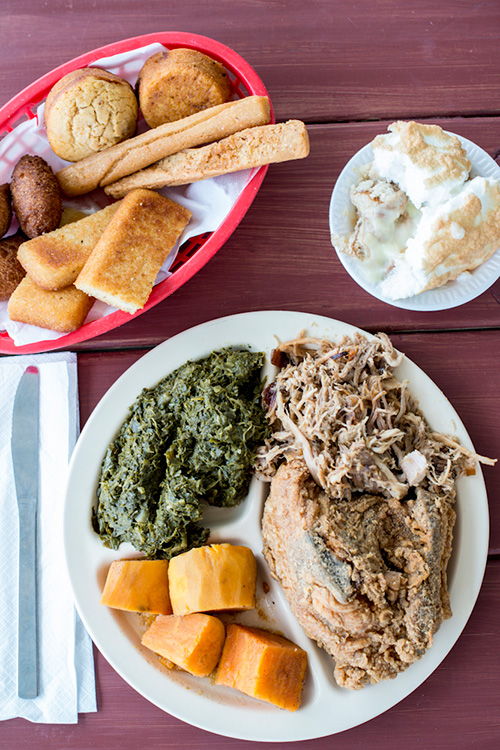Ever dream of leaving it all behind to seek out some of the best barbecue in the country? Rien Fertel did just that when he hit the road for The One True Barbecue, a new guide to the generations-old art of whole-hog barbecue and the hardworking pit masters who keep it alive. Paging through the impressive travelogue is the closest most readers will ever come to chopping wood with Rodney Scott of Scott’s Bar-B-Que in Hemingway, South Carolina, or chewing the fat behind the counter at Siler’s Old Time BBQ in Henderson, Tennessee.
Barbecue, though, is democratic. If you have a hankering for chopped pork and a few hours to kill, you can find a platter. But how do you know before you order if you’re getting real-deal, barbecue or a slow-cooker surprise? The experts say to look for wood and smoke, of course, but there’s more to the best joints than that. We asked Fertel for a few more signs.
The pits shouldn’t have “on” and “off” switches.
Purists might tell you that real barbecue starts at the chopping block, but Fertel disagrees. “There are a lot of joints nowadays where they just throw shoulders on a pit and flip a switch.” Such gas-powered pits don’t honor tradition, he says. Still, he doesn’t expect every pit master to split wood—just to burn it in some form. “To me, there just has to be real work being done. They need to light something on fire, whether it’s logs, chunks, or even charcoal. That speaks better to what barbecue is.” Skeptical about charcoal? Consider B’s Barbecue in Greenville, North Carolina, a forty-year-old institution that regularly makes national best-of lists for pork and chicken slow-cooked over lump charcoal. With a devoted clientele, the rickety restaurant is proof that the most important elements of barbecue are fire and time.

Photo: Peden + Munk
Stirring the coals at Helen’s Bar-B-Q in Brownsville, Tennessee.
The joint should reflect its surroundings…
“I think barbecue should be indicative of a place,” Fertel says. “Whole hog belongs in Eastern North Carolina. Brisket in the Texas Hill Country. I expect to see mustard sauce in parts of South Carolina and corn sticks and hush puppies on the side in Eastern North Carolina.”

Photo: Brennan Wesley
Rodney Scott seasons a hog.
…but offer something unique, too.
Almost every great barbecue joint has something distinctive—“even weird”—on the menu. Bum’s in Ayden, North Carolina, for example, has “phenomenal” sweet potato muffins alongside a typical lineup of whole-hog barbecue, corn sticks, and cabbage collards. Helen Turner of Helen’s Bar-B-Q in Brownsville, Tennessee, sells smoked bologna alongside pork sandwiches, and Jack O’Dell of Midway Barbecue in Buffalo, South Carolina, came up with the hearty chicken stew that’s a signature side dish.

Photo: (Photographs by Lissa Gotwals; Peden + Munk)
From left: The counter at Bum’s; Helen Turner.
The joint should have some personality.
“Barbecue places are known for being austere in their decorations, sort of plain” Fertel says. “Often people think of pig memorabilia and checkered tablecloths, and that is pretty drab.”
Sure, there are good joints out there with decorations straight out of the BBQ-R-Us Catalog. But from the kitschy capitol dome on top of the Skylight Inn in Ayden, North Carolina, to the smoke-stained cinderblock chimney at Archibald’s in Northport, Alabama, the looks of many longstanding barbecue joints are as distinctive as their menus.

Photo: Jed Portman
Lunchtime at the Skylight Inn in Ayden.
“Sweatman’s in Holly Hill, South Carolina, is a good example,” Fertel says. “They’ve maintained that old plantation farmhouse. The sign is small. There’s no neon. They’ve chosen not to chop it up and make it look like a barbecue joint.”
Don’t look for trophies. Listen for tall tales.
“At a true barbecue joint, they’re always willing to share their story with you,” Fertel says. “Some newer barbecue joints are just glorified trophy rooms, with awards won on the road. Those competition barbecue types just don’t tell a story like Larry Dennis at Bum’s in Ayden. His history spans hundreds of years, and it makes no sense. His stories are real, though, because people believe them. I think a barbecue business has to have a mythology.”








